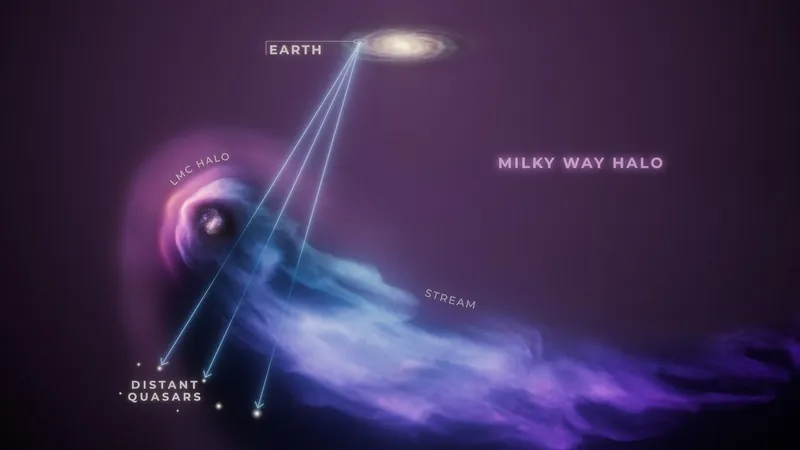
Hubble Reveals Stunning Aftermath of Large Magellanic Cloud's Encounter with the Milky Way
2024-11-14
Author: Olivia
Hubble Reveals Stunning Aftermath of Large Magellanic Cloud's Encounter with the Milky Way
A captivating story of cosmic resilience is unfolding at the fringes of our Milky Way galaxy, thanks to NASA's Hubble Space Telescope.
The Large Magellanic Cloud (LMC)
The Large Magellanic Cloud (LMC), a neighboring dwarf galaxy, dramatically punctuates the southern night sky, appearing impressively larger than the full moon—at a size about 20 times its diameter. While traditionally considered a satellite of the Milky Way, many scientists believe that the LMC is merely passing through our cosmic neighborhood rather than being gravitationally bound.
Recent Observations
Recent observations indicate that the LMC has just experienced its closest brush with the more massive Milky Way, leading to some astonishing consequences. Researchers have discovered that this passage has stripped away the majority of the gas that enveloped the LMC, particularly impacting its spherical halo—a critical component in a galaxy's ability to form new stars.
Study Findings
In an eye-opening new study set to be published in The Astrophysical Journal Letters, astronomers have measured the size of the LMC's remaining halo for the first time. Surprisingly, they found it to be remarkably compact, only about 50,000 light-years across—significantly smaller than halos of similarly-sized dwarf galaxies. This observation provides dramatic evidence of the LMC’s challenging history with our galaxy and its ability to endure substantial losses while continuing to create new stars.
Andrew Fox's Insights
Andrew Fox of AURA/STScI, the principal investigator of the observations, described the LMC as 'a survivor.' Despite suffering from gas loss, the galaxy continues to give birth to new stars, indicating that it retains enough material to foster ongoing stellar formation. He noted, "A smaller galaxy wouldn't have lasted; it would simply be left with aging red stars."
Mass and Resilience
The galaxy's resilience can be attributed to its mass—at 10 percent of the Milky Way’s mass, the LMC maintains a relatively hefty composition compared to its dwarf galaxy counterparts. This heftier body enables it to preserve a stubby halo of gas, a feat that would have been impossible for a less massive galaxy.
Ram-Pressure Stripping
Interestingly, the gravitational interaction with the Milky Way is described by researchers as a form of 'ram-pressure stripping,' which pushes gas away from the LMC. Fox elaborates, likening the interaction to a giant hairdryer blowing gas off the galaxy as it approaches the Milky Way. This phenomenon generates a trailing wake of gas, reminiscent of a comet’s tail.
Future Implications
As the LMC moves away from its closest approach, there is a belief that not all of its halo will be lost. The remaining gas could eventually rain down into the Milky Way, further contributing to its own gas reservoir.
Hubble's Unique Capabilities
A key aspect of this study was the exclusive capabilities of Hubble. Utilizing ultraviolet observations that are blocked by Earth's atmosphere, researchers tapped into the Mikulski Archive for Space Telescopes. Hubble’s unique infrastructure allowed the team to examine the halo by observing 28 bright quasars—extremely luminous objects powered by supermassive black holes—lit up by distant galaxies.
Analyzing Quasar Light Absorption
By analyzing the light absorption patterns from these quasars, scientists could uncover critical information regarding the halo's gas composition, velocity, and much more. This sort of analysis provides a glimpse into not only the dynamics of our cosmic neighborhood but also into the early universe when galaxies often interacted closely.
Future Research Directions
Looking forward, the research team is set to expand their investigations to explore the front side of the LMC’s halo—an area that remains enigmatic and has yet to be thoroughly analyzed. As cosmic explorations continue, the LMC remains a fascinating case study, deepening our understanding of galactic behavior and evolution over the vast stretches of time and space.
Stay tuned as we unlock more mysteries of our universe—who knows what breathtaking discoveries await?









 Brasil (PT)
Brasil (PT)
 Canada (EN)
Canada (EN)
 Chile (ES)
Chile (ES)
 España (ES)
España (ES)
 France (FR)
France (FR)
 Hong Kong (EN)
Hong Kong (EN)
 Italia (IT)
Italia (IT)
 日本 (JA)
日本 (JA)
 Magyarország (HU)
Magyarország (HU)
 Norge (NO)
Norge (NO)
 Polska (PL)
Polska (PL)
 Schweiz (DE)
Schweiz (DE)
 Singapore (EN)
Singapore (EN)
 Sverige (SV)
Sverige (SV)
 Suomi (FI)
Suomi (FI)
 Türkiye (TR)
Türkiye (TR)